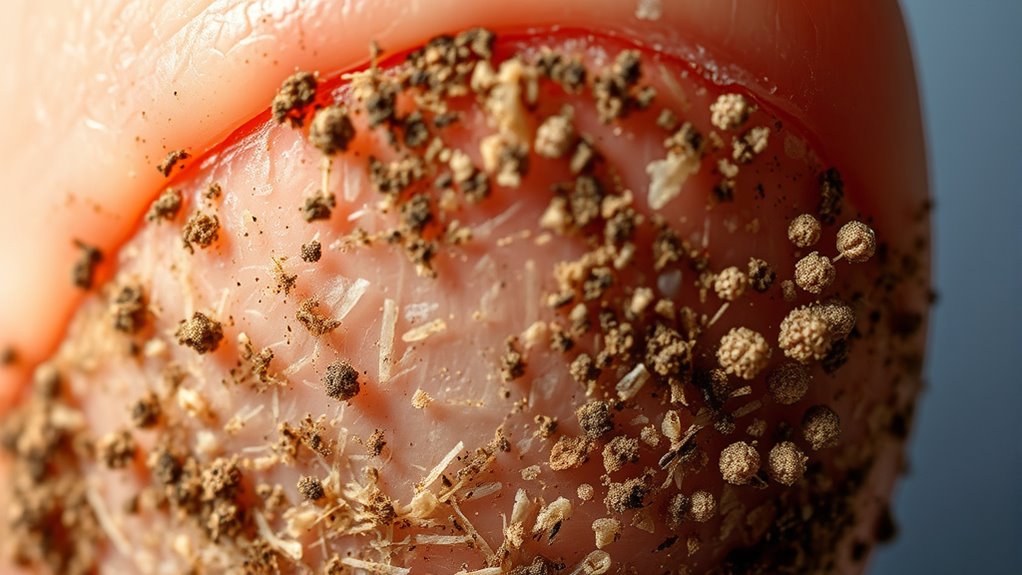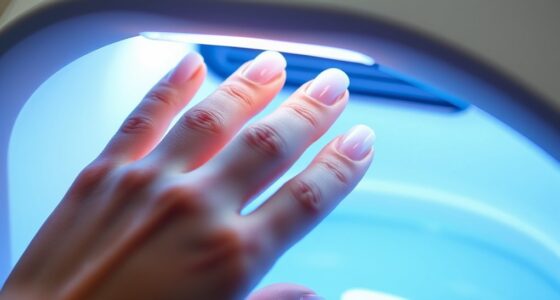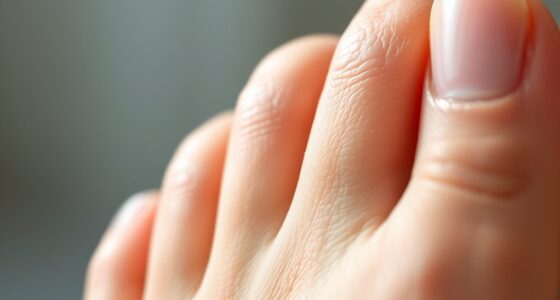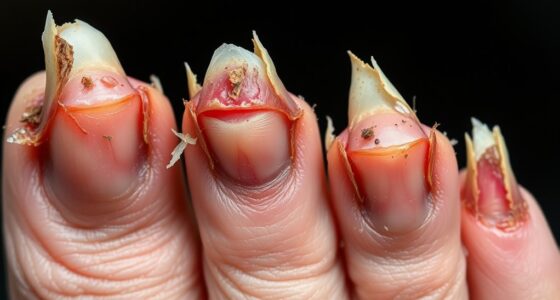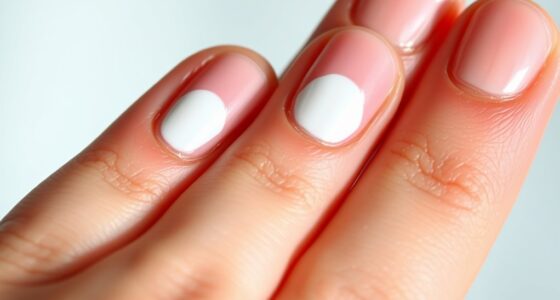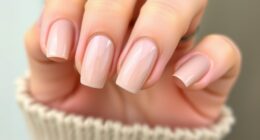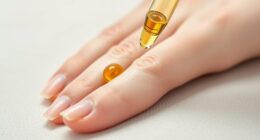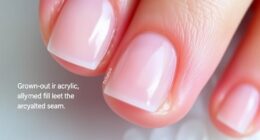Neglecting to clean under your nails lets microbes, like bacteria, viruses, and fungi, hide and multiply in tiny spaces, increasing your risk of infections and spreading germs. Dirt and debris trapped there serve as microbial reservoirs, especially in warm, moist areas. Regularly scrubbing your nails with a brush and washing your hands removes these hidden microbes, helping protect your health. Keep going to discover effective tips for keeping your nails clean and germ-free.
Key Takeaways
- Microbes can hide in tiny spaces beneath nails, serving as reservoirs for bacteria, viruses, and fungi.
- Proper cleaning and scrubbing under nails reduce microbial buildup and prevent transmission.
- Neglecting nail hygiene increases the risk of microbes transferring to the mouth, food, or other surfaces.
- Microbes under nails can cause infections or illnesses if they enter the body through cuts or contact.
- Regular nail maintenance and hygiene are essential for overall health and minimizing infection risks.
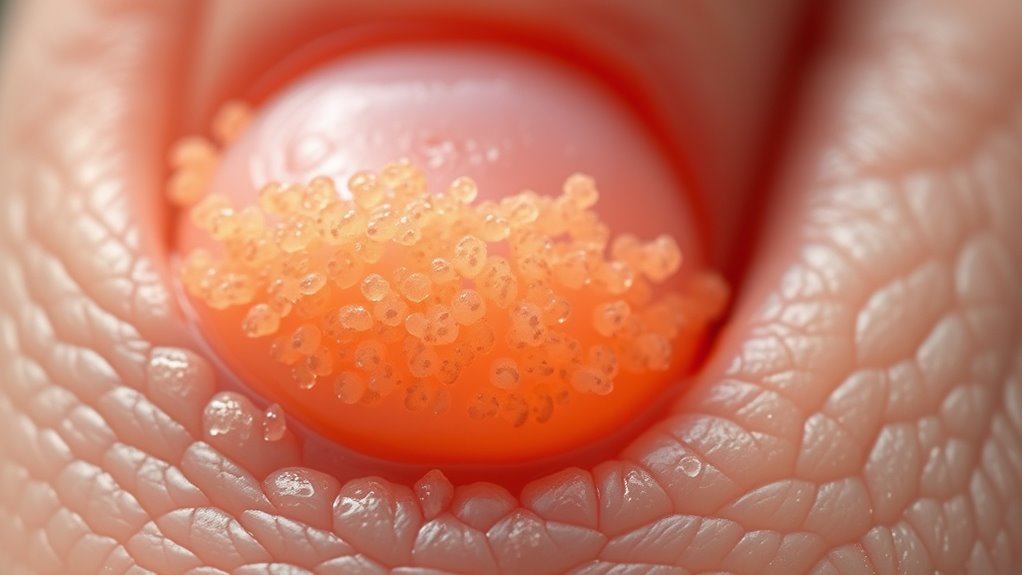
Many of us overlook what hides beneath our nails, but these tiny spaces can harbor a surprising number of microbes. This makes nail hygiene more important than you might think, especially considering how easily microbes can transfer from your hands to your mouth, food, or other surfaces. The dirt and debris trapped under your nails aren’t just unsightly—they’re potential hotspots for bacteria, viruses, and fungi. When you neglect proper nail care, you increase the risk of microbial transmission, which can lead to illnesses ranging from minor stomach upset to more serious infections.
Your nails act like small reservoirs, collecting dirt, bacteria, and other microbes throughout the day. Every time you touch a surface, shake hands, or scratch an itch, those microbes hitch a ride onto your skin or transfer elsewhere. If your nails aren’t kept clean, these microbes can easily find their way into your body through your mouth, eyes, or cuts. This is why maintaining good nail hygiene is essential; it’s your first line of defense against microbial transmission. Regularly trimming your nails and cleaning beneath them helps eliminate the hiding spots microbes love. Remember, microbes thrive in warm, moist environments, and the space under your nails provides exactly that.
You might think a quick wash with soap removes all the germs, but it’s not enough if you don’t pay attention to your nails. Use a nail brush or a soft toothbrush to scrub beneath your nails thoroughly. Don’t forget to wash your hands afterward—soap and water are your best tools against microbial buildup. Avoid biting your nails or picking at cuticles, as these habits can break the skin barrier, making it easier for microbes to enter your body. Also, consider using hand sanitizer when soap isn’t available, but keep in mind that sanitizer isn’t as effective at cleaning under nails as soap and water.
Practicing good nail hygiene isn’t just about appearance; it’s about health. By keeping your nails clean and trimmed, you reduce the chances of microbes lurking in those tiny crevices from making you sick. Proper nail care limits microbial transmission, helping you stay healthier day-to-day. Remember, the small effort of maintaining clean nails can have a big impact on your overall well-being. So, next time you wash your hands, make sure to give your nails some extra attention—you might just prevent an illness before it starts. Additionally, emerging AI-powered cleaning tools are now available, offering more efficient ways to sanitize difficult-to-reach areas like under your nails.
Frequently Asked Questions
Can Nail Polish Prevent Microbial Buildup Under Nails?
Nail polish might seem like a barrier, but it doesn’t effectively prevent microbial growth under your nails. In fact, it can trap dirt and bacteria, making hygiene worse if not removed regularly. To truly prevent microbial buildup, you should prioritize regular hand washing and cleaning under your nails. Nail polish alone isn’t enough for microbial growth prevention; maintaining good hygiene is essential for healthy, germ-free nails.
Do Artificial Nails Harbor More Microbes Than Natural Nails?
Artificial nails often harbor more microbes than natural nails because they create a sealed environment that traps dirt and bacteria. You might notice increased microbial buildup under artificial nails if you don’t clean them regularly. This buildup can lead to infections or other hygiene issues. To reduce microbial growth, make sure to clean underneath artificial nails thoroughly and give your natural nails a break periodically.
How Often Should I Trim My Nails to Reduce Microbes?
Think of your nails like a garden—if you don’t trim them regularly, weeds (microbes) take over. To reduce microbes, you should trim your nails every one to two weeks. This nail trimming frequency keeps dirt and bacteria at bay, reducing microbial buildup. Staying consistent with this routine helps maintain healthier nails and overall hygiene, just like tending a garden keeps it lush and thriving.
Are There Specific Hand Sanitizers Effective Under Nails?
When choosing hand sanitizer, look for those with at least 60% alcohol for effective hand hygiene. While hand sanitizer effectiveness can vary, it doesn’t always reach microbes under your nails. For better nail hygiene, consider using specialized nail hygiene products like brushes or disinfectant sprays designed for nails. These products help target microbes under your nails more effectively than standard hand sanitizers alone, ensuring thorough cleanliness.
Can Microbes Under Nails Cause Long-Term Health Issues?
Microbes under your nails can potentially cause long-term health issues if they lead to ongoing germ transmission. When these microbes enter your body through cuts or contaminated hands, they may challenge your immune system, making you more susceptible to infections. Regularly cleaning your nails helps reduce microbial buildup, decreasing the risk of germs causing persistent health problems and supporting your immune system in staying strong.
Conclusion
So, next time you think about skipping nail cleaning, remember the tiny microbes hiding beneath. They’re invisible enemies, yet they can cause big problems if left unchecked. Clean nails might seem small, but they’re your first line of defense against germs. It’s a simple act with powerful consequences. Don’t let microscopic invaders go unnoticed—your health depends on the tiny, everyday choices you make. Keep your nails clean and stay one step ahead of the unseen threats.
